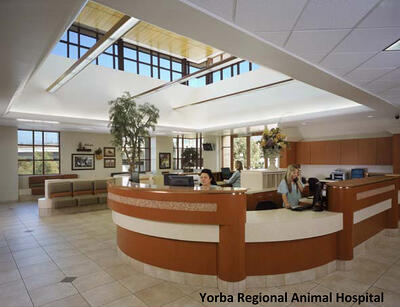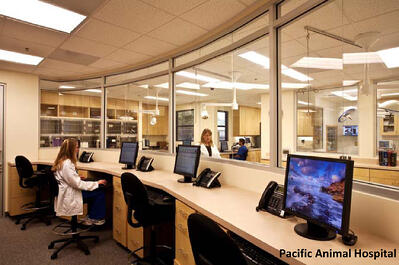Bring nature indoors and organize work space to promote teamwork and boost staff spirits.
Brought to you by Contributing Editor Richard M. Rauh, AIA, NCARB of rauhaus freedenfeld & associates.
If you’re a progressive practice owner, you recognize the importance of creating an employee friendly work environment. You strive to build a culture of trust and mutual respect, emphasizing teamwork, involvement and open communication, while trying to maintain a healthy work/life balance for everyone on your staff.
So you’ve carefully aligned all your human resources and management policies – virtually every aspect of your day-to-day operations – to achieve this goal. But there’s one element you may have overlooked: your hospital’s physical work space.

As an architect, I have collaborated with veterinarians for more than 26 years. I’ve learned that creating a sense of place is essential to shaping the culture of a practice. Employees will not only be happier, they’ll be healthier, too. A recent survey conducted by the University of San Diego found that workers in “green” buildings are more productive and call in sick less often.
By creating positive employee environments, worker retention is also enhanced. And if that’s not incentive enough, several studies show patients recover faster in “green” hospital buildings. A decrease in patient recovery time brings the potential for increased productivity, revenue and client satisfaction. How can you tell if your facility is employee-friendly? Ask yourself the following questions:
- Does your facility provide a sense of place that gives employees ownership of their work and empowers them to make a difference?
- How does your hospital’s design promote a spirit of unity and teamwork to boost morale and foster change?
- Does the design of the space reflect a sense of forward thinking and compelling vision for your staff?
- Does it evoke a sense of meaning and purpose for your employees’ specific roles in the practice?
- Is the practice pleasant to work in? Are the colors and spaces uplifting and emotionally friendly?
- What special employee amenities are there currently in the practice?
- Is the practice designed throughout with technological efficiency?
- Does the design incorporate “places of honor” by recognizing and celebrating employees’ accomplishments?
- Are there positive, interactive private indoor/outdoor conference areas of the hospital where principals can socially interact with employees to promote a sense of community?
Ironically, one of the most influential figures in designing employee-friendly work spaces is not an architect, but a scientist. We know that both human and animals respond to nature on a cellular level.
Harvard biologist Edward Wilson calls this psychological dependence on the natural world “biophilia”. It’s the love of nature, the human propensity to affiliate with other life forms. I’d argue that few humans exhibit this propensity more often or more passionately than veterinarians.

Design professionals instinctively want to bring the natural environment into our buildings through the use of natural daylight and exterior elements. Large windows, skylights, courtyards and faux trees are all ways of achieving this ingrained desire to be outdoors. When designing break rooms, we try to link them to an outdoor amenity, like a small patio or shade pavilion. This can serve as an alternative location for office meetings and employee appreciation events. We create a space for more social interaction, a place for people to bond.
Another bonding area is created by what we call the “fishbowl office”. This is strategically located within the treatment area. Doctors and technicians are able to make follow-up calls in a quieter environment, while still having visual control and monitoring of the treatment and CCU areas of the hospital. They can also talk about their caseloads, what’s happening and interact with each other on a more personal level.
Improved indoor air quality also makes for a more employee-friendly facility. In a highly sensitive indoor environment where the spread of bacterial and viral infections is a major concern, indoor air quality can have a significant impact on employees and their patients. Increasing outdoor ventilation rates in animal holding areas will help purge the building of odor and bacterial contaminants.
Another increasingly popular strategy is to install ultraviolet germicidal irradiation systems. These systems use ultraviolet light to kill or neutralize many microorganisms. These lamps can be installed directly in the mechanical system ductwork to help clean and sterilize the air.
With budgets strained and people re-evaluating their needs, animal care facilities must be designed to maximize efficiency by using the least amount of space and still provide for future growth. This can be a challenge, especially for smaller practices. When considering changes to my wife’s 2,600 square foot clinic, we measure by the square inch, not the square foot. It’s always a struggle to balance employee creature comforts with what is considered the hospital’s profit centers. But, in reality, even break rooms contribute to a practice’s bottom line when employees are incented to work harder and feel a sense of place that gives them a sense of authorship of their work.

The green movement has infiltrated our political, social and economic lives and is now catching on in the veterinary community. In the United States, buildings account for almost 40% of greenhouse gas emissions. Owners can have an enormous impact on the environment when they renovate or build a new animal care facility. Aside from being more energy efficient, green buildings provide great benefit to a practice in terms of marketing and employee retention.
But you don’t need to embark on a major renovation project to make an impact with your employees. Your staff will notice any physical improvements – even a fresh coat of paint - that are implemented with the purpose of making their work space more efficient, comfortable and, most importantly, happy.
Richard Rauh is a principal in the architectural firm of Rauhaus Freedenfeld & Associates
